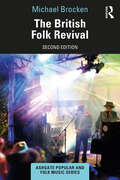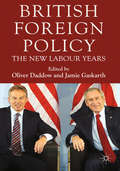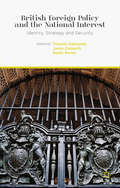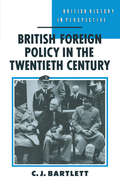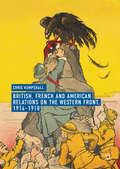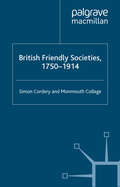- Table View
- List View
The British Folk Revival: A Second Edition (Ashgate Popular and Folk Music Series)
by Michael BrockenAlmost 20 years ago Michael Brocken created from his doctoral research, what became both a seminal and contested volume concerning the social mores surrounding the British Folk Revival up to that point in time: The British Folk Revival 1944–2002. In this long-overdue second edition he revisits not only his own research, but also that of others from the 1990s and early 21st century. He then considers how a discourse of folkloric authenticity emerged in the closing years of the 19th century and how a worrying nationalistic immanence came to surround folk music and dance during the inter-war years. Brocken also proposes that the media: records, radio and TV in post-WWII folk revivalism can offer us important insights into how self-directed learning of the folk guitar emerged. Brocken moves on to consider the business structures of the contemporary folk scene and how relationships are formed between contemporary folk business and the digital and social media spheres. In his penultimate chapter he discusses the masculinisation of folk traditions and asks important questions about how our folk traditions are carried and are authorised. In the final chapter he also considers the rise of an exciting new folk live music built environment.
The British Folk Revival (Ashgate Popular and Folk Music Series)
by Michael BrockenAlmost 20 years ago Michael Brocken created from his doctoral research, what became both a seminal and contested volume concerning the social mores surrounding the British Folk Revival up to that point in time: The British Folk Revival 1944–2002. In this long-overdue second edition he revisits not only his own research, but also that of others from the 1990s and early 21st century. He then considers how a discourse of folkloric authenticity emerged in the closing years of the 19th century and how a worrying nationalistic immanence came to surround folk music and dance during the inter-war years. Brocken also proposes that the media: records, radio and TV in post-WWII folk revivalism can offer us important insights into how self-directed learning of the folk guitar emerged. Brocken moves on to consider the business structures of the contemporary folk scene and how relationships are formed between contemporary folk business and the digital and social media spheres. In his penultimate chapter he discusses the masculinisation of folk traditions and asks important questions about how our folk traditions are carried and are authorised. In the final chapter he also considers the rise of an exciting new folk live music built environment.
British Food Policy During the First World War (Routledge Library Editions: The First World War)
by Margaret BarnettBecause of the exceptionally high proportion of imports in Britain’s food supply and the determined efforts of the enemy to sever the supply lines, efficient management of food resources was an essential element in the British national war effort. This volume was the first comprehensive study of this vital aspect of government strategy and fills a gap in the historiography of this period. This volume provides a balanced picture by drawing together the diverse elements that went into food policy: economic and social trends, international trade relations and labour issues. The author also traces the evolution of food policy during the pre-war planning period and the early part of the war, and analyses the roles of the United States and the labour organizations.
British Food Policy During the First World War (Routledge Library Editions: The First World War)
by Margaret BarnettBecause of the exceptionally high proportion of imports in Britain’s food supply and the determined efforts of the enemy to sever the supply lines, efficient management of food resources was an essential element in the British national war effort. This volume was the first comprehensive study of this vital aspect of government strategy and fills a gap in the historiography of this period. This volume provides a balanced picture by drawing together the diverse elements that went into food policy: economic and social trends, international trade relations and labour issues. The author also traces the evolution of food policy during the pre-war planning period and the early part of the war, and analyses the roles of the United States and the labour organizations.
British Foreign and Imperial Policy 1865–1919
by Graham GoodladBritish Foreign and Imperial Policy explores Britains role in International Affairs from the age of Gladstone and Disraeli to the end of the First World War, exploring such themes as Britain's involvement in the Scramble for Africa, the Anglo-Boer War, the foreign policy of Lord Salisbury and the prospects for Britain and the Empire at the end of the First World War.
British Foreign and Imperial Policy 1865–1919
by Graham GoodladBritish Foreign and Imperial Policy explores Britains role in International Affairs from the age of Gladstone and Disraeli to the end of the First World War, exploring such themes as Britain's involvement in the Scramble for Africa, the Anglo-Boer War, the foreign policy of Lord Salisbury and the prospects for Britain and the Empire at the end of the First World War.
British Foreign Policy: The New Labour Years
by Oliver Daddow and Jamie GaskarthA major review of New Labour's foreign policy from leading experts. This book re-imagines policy thinking, away from Churchill's idea of Britain as at the intersection of 'three circles' (the English speaking world, Europe, and the Commonwealth) and towards a new conceptual model that takes into account identity, ethics and power.
British Foreign Policy and the National Interest: Identity, Strategy and Security
by Jamie Gaskarth Robin Porter Timothy EdmundsWhose interests does British foreign policy serve? Is the national interest a useful explanatory tool for foreign policy analysts? This interdisciplinary collection responds to these questions exploring ideas of Britain's national interest and their impact on strategy, challenging current thinking and practice in the making of foreign policy.
British Foreign Policy during the Curzon Period, 1919-24 (Studies in Military and Strategic History)
by G. BennettA wide-ranging and authoritative study of British foreign policy in the critical years after the 1919 Paris Peace Conference. Policy towards Western and Eastern Europe, Russia, Turkey, the Middle East, United States and Far East is examined alongside such themes as the role of Prime Minister, Foreign Secretary and Cabinet in policy formulation. The evolution and execution of policy is set alongside the limitations imposed on British statesmen by the dominions, armed forces, economic weakness and domestic politics.
British Foreign Policy in the Twentieth Century (British History in Perspective)
by C.J. BartlettThis is an analysis of the main decisions and turning points in British foreign policy in this century, and of the scholarly controversies which these provoked. Although some historians argue that Britain's declining power and reluctance to adapt to new challenges largely predetermined the policies pursued, many insist that it was not inevitable that Britain should have chosen to draw closer to France and Russia before 1914, have followed the disastrous path of appeasement before 1939, or have failed to enter the EEC until the 1970s.
British Freemasonry, 1717-1813 (Routledge Historical Resources)
by Robert PeterFreemasonry was a major cultural and social phenomenon and a key element of the Enlightenment. It was to have an international influence across the globe. This primary resource collection charts a key period in the development of organized Freemasonry culminating in the formation of a single United Grand Lodge of England. The secrecy that has surrounded Freemasonry has made it difficult to access information and documents about the organization and its adherents in the past. This collection is the result of extensive archival research and transcription and highlights the most significant themes associated with Freemasonry. The documents are drawn from masonic collections, private archives and libraries worldwide. The majority of these texts have never before been republished. Documents include rituals (some written in code), funeral services, sermons, songs, certificates, an engraved list of lodges, letters, pamphlets, theatrical prologues and epilogues, and articles from newspapers and periodicals. This collection will enable researchers to identify many key masons for the first time. It will be of interest to students of Freemasonry, the Enlightenment and researchers in eighteenth-century studies. Includes more than 550 texts - Many texts are published here by special arrangement with the Library and Museum of Freemasonry, London - Contains over 260 pages of newly transcribed manuscript material - Documents are organized thematically - Full editorial apparatus including general introduction, volume introductions, headnotes and explanatory endnotes - A consolidated index appears in the final volume
British Freemasonry, 1717-1813 (Routledge Historical Resources)
by Cécile Révauger Róbert PéterFreemasonry was a major cultural and social phenomenon and a key element of the Enlightenment. It was to have an international influence across the globe. This primary resource collection charts a key period in the development of organized Freemasonry culminating in the formation of a single United Grand Lodge of England. The secrecy that has surrounded Freemasonry has made it difficult to access information and documents about the organization and its adherents in the past. This collection is the result of extensive archival research and transcription and highlights the most significant themes associated with Freemasonry. The documents are drawn from masonic collections, private archives and libraries worldwide. The majority of these texts have never before been republished. Documents include rituals (some written in code), funeral services, sermons, songs, certificates, an engraved list of lodges, letters, pamphlets, theatrical prologues and epilogues, and articles from newspapers and periodicals. This collection will enable researchers to identify many key masons for the first time. It will be of interest to students of Freemasonry, the Enlightenment and researchers in eighteenth-century studies. Includes more than 550 texts - Many texts are published here by special arrangement with the Library and Museum of Freemasonry, London - Contains over 260 pages of newly transcribed manuscript material - Documents are organized thematically - Full editorial apparatus including general introduction, volume introductions, headnotes and explanatory endnotes - A consolidated index appears in the final volume
British Freemasonry, 1717-1813 Volume 1
by Robert PeterFreemasonry was a major cultural and social phenomenon and a key element of the Enlightenment. It was to have an international influence across the globe. This primary resource collection charts a key period in the development of organized Freemasonry culminating in the formation of a single United Grand Lodge of England. The secrecy that has surrounded Freemasonry has made it difficult to access information and documents about the organization and its adherents in the past. This collection is the result of extensive archival research and transcription and highlights the most significant themes associated with Freemasonry. The documents are drawn from masonic collections, private archives and libraries worldwide. The majority of these texts have never before been republished. Documents include rituals (some written in code), funeral services, sermons, songs, certificates, an engraved list of lodges, letters, pamphlets, theatrical prologues and epilogues, and articles from newspapers and periodicals. This collection will enable researchers to identify many key masons for the first time. It will be of interest to students of Freemasonry, the Enlightenment and researchers in eighteenth-century studies.
British Freemasonry, 1717-1813 Volume 1
by Cécile Révauger Róbert PéterFreemasonry was a major cultural and social phenomenon and a key element of the Enlightenment. It was to have an international influence across the globe. This primary resource collection charts a key period in the development of organized Freemasonry culminating in the formation of a single United Grand Lodge of England. The secrecy that has surrounded Freemasonry has made it difficult to access information and documents about the organization and its adherents in the past. This collection is the result of extensive archival research and transcription and highlights the most significant themes associated with Freemasonry. The documents are drawn from masonic collections, private archives and libraries worldwide. The majority of these texts have never before been republished. Documents include rituals (some written in code), funeral services, sermons, songs, certificates, an engraved list of lodges, letters, pamphlets, theatrical prologues and epilogues, and articles from newspapers and periodicals. This collection will enable researchers to identify many key masons for the first time. It will be of interest to students of Freemasonry, the Enlightenment and researchers in eighteenth-century studies.
British Freemasonry, 1717-1813 Volume 2
by Robert PeterFreemasonry was a major cultural and social phenomenon and a key element of the Enlightenment. It was to have an international influence across the globe. This primary resource collection charts a key period in the development of organized Freemasonry culminating in the formation of a single United Grand Lodge of England. The secrecy that has surrounded Freemasonry has made it difficult to access information and documents about the organization and its adherents in the past. This collection is the result of extensive archival research and transcription and highlights the most significant themes associated with Freemasonry. The documents are drawn from masonic collections, private archives and libraries worldwide. The majority of these texts have never before been republished. Documents include rituals (some written in code), funeral services, sermons, songs, certificates, an engraved list of lodges, letters, pamphlets, theatrical prologues and epilogues, and articles from newspapers and periodicals. This collection will enable researchers to identify many key masons for the first time. It will be of interest to students of Freemasonry, the Enlightenment and researchers in eighteenth-century studies.
British Freemasonry, 1717-1813 Volume 2
by Snoek Jan A. M.Freemasonry was a major cultural and social phenomenon and a key element of the Enlightenment. It was to have an international influence across the globe. This primary resource collection charts a key period in the development of organized Freemasonry culminating in the formation of a single United Grand Lodge of England. The secrecy that has surrounded Freemasonry has made it difficult to access information and documents about the organization and its adherents in the past. This collection is the result of extensive archival research and transcription and highlights the most significant themes associated with Freemasonry. The documents are drawn from masonic collections, private archives and libraries worldwide. The majority of these texts have never before been republished. Documents include rituals (some written in code), funeral services, sermons, songs, certificates, an engraved list of lodges, letters, pamphlets, theatrical prologues and epilogues, and articles from newspapers and periodicals. This collection will enable researchers to identify many key masons for the first time. It will be of interest to students of Freemasonry, the Enlightenment and researchers in eighteenth-century studies.
British Freemasonry, 1717-1813 Volume 3
by Robert PeterFreemasonry was a major cultural and social phenomenon and a key element of the Enlightenment. It was to have an international influence across the globe. This primary resource collection charts a key period in the development of organized Freemasonry culminating in the formation of a single United Grand Lodge of England. The secrecy that has surrounded Freemasonry has made it difficult to access information and documents about the organization and its adherents in the past. This collection is the result of extensive archival research and transcription and highlights the most significant themes associated with Freemasonry. The documents are drawn from masonic collections, private archives and libraries worldwide. The majority of these texts have never before been republished. Documents include rituals (some written in code), funeral services, sermons, songs, certificates, an engraved list of lodges, letters, pamphlets, theatrical prologues and epilogues, and articles from newspapers and periodicals. This collection will enable researchers to identify many key masons for the first time. It will be of interest to students of Freemasonry, the Enlightenment and researchers in eighteenth-century studies.
British Freemasonry, 1717-1813 Volume 3
by Snoek Jan A. M.Freemasonry was a major cultural and social phenomenon and a key element of the Enlightenment. It was to have an international influence across the globe. This primary resource collection charts a key period in the development of organized Freemasonry culminating in the formation of a single United Grand Lodge of England. The secrecy that has surrounded Freemasonry has made it difficult to access information and documents about the organization and its adherents in the past. This collection is the result of extensive archival research and transcription and highlights the most significant themes associated with Freemasonry. The documents are drawn from masonic collections, private archives and libraries worldwide. The majority of these texts have never before been republished. Documents include rituals (some written in code), funeral services, sermons, songs, certificates, an engraved list of lodges, letters, pamphlets, theatrical prologues and epilogues, and articles from newspapers and periodicals. This collection will enable researchers to identify many key masons for the first time. It will be of interest to students of Freemasonry, the Enlightenment and researchers in eighteenth-century studies.
British Freemasonry, 1717-1813 Volume 4
by Robert PeterFreemasonry was a major cultural and social phenomenon and a key element of the Enlightenment. It was to have an international influence across the globe. This primary resource collection charts a key period in the development of organized Freemasonry culminating in the formation of a single United Grand Lodge of England. The secrecy that has surrounded Freemasonry has made it difficult to access information and documents about the organization and its adherents in the past. This collection is the result of extensive archival research and transcription and highlights the most significant themes associated with Freemasonry. The documents are drawn from masonic collections, private archives and libraries worldwide. The majority of these texts have never before been republished. Documents include rituals (some written in code), funeral services, sermons, songs, certificates, an engraved list of lodges, letters, pamphlets, theatrical prologues and epilogues, and articles from newspapers and periodicals. This collection will enable researchers to identify many key masons for the first time. It will be of interest to students of Freemasonry, the Enlightenment and researchers in eighteenth-century studies.
British Freemasonry, 1717-1813 Volume 4
by Snoek Jan A. M.Freemasonry was a major cultural and social phenomenon and a key element of the Enlightenment. It was to have an international influence across the globe. This primary resource collection charts a key period in the development of organized Freemasonry culminating in the formation of a single United Grand Lodge of England. The secrecy that has surrounded Freemasonry has made it difficult to access information and documents about the organization and its adherents in the past. This collection is the result of extensive archival research and transcription and highlights the most significant themes associated with Freemasonry. The documents are drawn from masonic collections, private archives and libraries worldwide. The majority of these texts have never before been republished. Documents include rituals (some written in code), funeral services, sermons, songs, certificates, an engraved list of lodges, letters, pamphlets, theatrical prologues and epilogues, and articles from newspapers and periodicals. This collection will enable researchers to identify many key masons for the first time. It will be of interest to students of Freemasonry, the Enlightenment and researchers in eighteenth-century studies.
British Freemasonry, 1717-1813 Volume 5 (Routledge Historical Resources)
by Robert PeterFreemasonry was a major cultural and social phenomenon and a key element of the Enlightenment. It was to have an international influence across the globe. This primary resource collection charts a key period in the development of organized Freemasonry culminating in the formation of a single United Grand Lodge of England. The secrecy that has surrounded Freemasonry has made it difficult to access information and documents about the organization and its adherents in the past. This collection is the result of extensive archival research and transcription and highlights the most significant themes associated with Freemasonry. The documents are drawn from masonic collections, private archives and libraries worldwide. The majority of these texts have never before been republished. Documents include rituals (some written in code), funeral services, sermons, songs, certificates, an engraved list of lodges, letters, pamphlets, theatrical prologues and epilogues, and articles from newspapers and periodicals. This collection will enable researchers to identify many key masons for the first time. It will be of interest to students of Freemasonry, the Enlightenment and researchers in eighteenth-century studies.
British Freemasonry, 1717-1813 Volume 5 (Routledge Historical Resources)
by Róbert PéterFreemasonry was a major cultural and social phenomenon and a key element of the Enlightenment. It was to have an international influence across the globe. This primary resource collection charts a key period in the development of organized Freemasonry culminating in the formation of a single United Grand Lodge of England. The secrecy that has surrounded Freemasonry has made it difficult to access information and documents about the organization and its adherents in the past. This collection is the result of extensive archival research and transcription and highlights the most significant themes associated with Freemasonry. The documents are drawn from masonic collections, private archives and libraries worldwide. The majority of these texts have never before been republished. Documents include rituals (some written in code), funeral services, sermons, songs, certificates, an engraved list of lodges, letters, pamphlets, theatrical prologues and epilogues, and articles from newspapers and periodicals. This collection will enable researchers to identify many key masons for the first time. It will be of interest to students of Freemasonry, the Enlightenment and researchers in eighteenth-century studies.
British, French and American Relations on the Western Front, 1914–1918
by Chris KempshallThis book provides a thorough examination of the relations between the men in the British, French and American armies on the Western Front of the First World War. The Allied victory in 1918 was built on the backs of British, French, and American soldiers who joined together to fight for a common cause. Using the diaries, records, and letters of these men, Chris Kempshall shows how these soldiers interacted with each other during four years of war. The British army that arrived in France in 1914 became isolated from their French allies and unable to coordinate with them. By 1916, Britain’s professional soldiers were replaced by civilians who learned to love their French ally, who reached out to them in friendship. At the end of the war the introduction of American soldiers caused hope and conflict before perceived British failures brought the alliance to the brink of collapse. Final cooperation between these three nations saw them victorious.
British, French and American Relations on the Western Front, 1914–1918
by Chris KempshallThis book provides a thorough examination of the relations between the men in the British, French and American armies on the Western Front of the First World War. The Allied victory in 1918 was built on the backs of British, French, and American soldiers who joined together to fight for a common cause. Using the diaries, records, and letters of these men, Chris Kempshall shows how these soldiers interacted with each other during four years of war. The British army that arrived in France in 1914 became isolated from their French allies and unable to coordinate with them. By 1916, Britain’s professional soldiers were replaced by civilians who learned to love their French ally, who reached out to them in friendship. At the end of the war the introduction of American soldiers caused hope and conflict before perceived British failures brought the alliance to the brink of collapse. Final cooperation between these three nations saw them victorious.
British Friendly Societies, 1750-1914
by S. CorderyThe first monograph on this topic since 1961, this book provides an innovative interpretation of the Friendly Societies in Britain from the perspectives on social, gender and political history. It establishes the central role of the Friendly Societies in the political activism of British workers, changing understandings of masculinity and femininity, the ritualised expression of social tensions and the origins of the welfare state.
